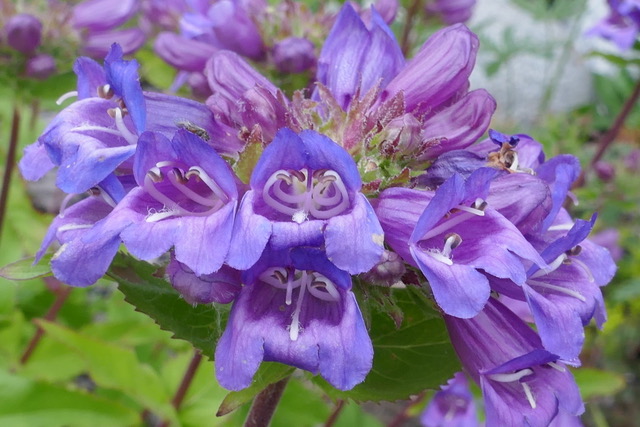by Barbara Faurot • The most versatile garden plants have something in common: they are easy to grow, can
tolerate deer and drought, and offer an array of habitat benefits in all seasons.
Penstemons deliver on all counts — plus they offer a variety of colors, foliage types, blooming
seasons, and sizes. Most Pacific Northwest natives and cultivars will thrive in our maritime
climate. As the Oregon Native Plant Society says, they offer “a charm in their carefree attitude,”
requiring little care and attention once established in the garden.
Penstemons belong to the plantain (Plantaginaceae) family. The botanical name penstemon is
derived from the Greek words penta (five) and stemon (stamen). One of the five stamens (the
male parts of the flower that produce pollen) is sterile and covered with hairs, leading to its
common name “beard-tongue.” Flowers bloom in spires of tubular flowers, with two lobes on
the upper lip and three on the hairy lower lip of each flower.
Penstemons are the largest genus of flowering plants endemic to North America, with about 280
species on the continent. There are about 30 species native to Washington state and 80 species
in the greater Northwest. Hundreds of hybrids and cultivars are also available with names that
describe their brilliant colors, including Electric Blue, Prairie Dusk, Pink Rock Candy, and
Peregrine Lilac.
Whether native or cultivated species, nearly all are outstanding pollinator plants, attracting
honey bees, native bees, pollen-collecting wasps, and butterflies. The non-profit Xerces Society
explains that different plants attract different pollinators. Red-flowering penstemons attract
hummingbirds, while others support sphinx moths. Smaller varieties have nectaries
(nectar-producing glands) accessible to smaller bees.
Penstemons are strong multi-taskers in the garden. In addition to producing pollen and nectar,
they are excellent host plants for caterpillars and provide pollinator nesting material and shelter.
Seeds are a valuable food source for small birds and mammals. Penstemons also help prevent
soil erosion and help improve soil quality through their root systems.
The tallest species are about four feet high and can work well on the sunny edges of
hedgerows; smaller varieties can thrive in wildflower meadows and perennial borders. Many
bloom throughout the season, and most prefer sun to part shade and average to dry soil. Once established, they require little supplemental irrigation, and resist pests and diseases if they are
not over-watered.
After flowers bloom, you can simply leave them to develop seeds for birds and provide nesting
materials for wildlife. If desired, deadhead larger-flowered types to promote continuous bloom,
and remove stems from bushier plants to encourage new basal shoots.
Kul Kah Han Native Plant Garden at HJ Carroll Park in Chimacum has several species native to
the Pacific Northwest on display. Cascade penstemon (Penstemon serrulatus) blooms all
summer with purple flowers; unlike most, it favors more moisture. The small-flowered
penstemon (P. procurus) prefers rocky, meadow, and dry conditions; blue-purple, tube-like
flowers bloom from mid- to late summer.
Venus, Palmer’s, Barrett’s, and Eaton’s penstemons are other natives that prefer sunny sites
and well-drained soil. Local nurseries offer hearty cultivars; Pink Rock Candy, for example, is a
semi-shrubby plant that attracts pollinators and easily self-sows.
Plant penstemons with other native species for a beautiful and functional wildlife habitat. For
starters, in sunny sites consider Douglas aster (Symphyotrichum subspicatum), Oregon iris (Iris
tenax), blue-eyed grass (Sisyrinchium spp.), and yarrow (Achillea millefolium).
Fall is a great time to plant penstemons. New plantings require supplemental water as their root
systems grow, but need little additional care once established. Layer finished compost or coarse
organic mulch around plantings; no commercial fertilizers or pesticides are needed.
Reginald Farrer, late plantsman and writer, observed that “penstemons … prefer a crowded
hour of glory rather than a long existence of mere usefulness.” A typical penstemon may have a
lifespan of five to ten years. Many will self-seed and can be divided to encourage a continuous
colorful display as part of a sunny border, wildflower meadow, or pollinator garden.
For more information, visit the American Penstemon Society at https://penstemons.org.
Barbara Faurot is a Jefferson County Master Gardener and Master Pruner, working with other
volunteers who serve as community educators in gardening and environmental stewardship.
“First published in the Port Townsend Leader August 28, 2024.”


